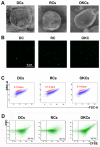Increased level of cell-derived microparticles in the cyst fluids of odontogenic keratocysts
- PMID: 29620170
- PMCID: PMC5919707
- DOI: 10.3892/ijo.2018.4361
Increased level of cell-derived microparticles in the cyst fluids of odontogenic keratocysts
Abstract
The aim of this study was to examine the level and basic characteristics of cell‑derived microparticles (MPs) in the cyst fluids of odontogenic keratocysts (OKCs). For this purpose, MPs from the cyst fluids (CFMPs) of OKCs were purified by a classic differential centrifugation method and characterized by a transmission electron microscope and fluorescence microscope. Flow cytometric analysis was used to determine the size, concentration and cellular origins of the CFMPs. Moreover, the expression level of receptor activator for nuclear factor‑κB ligand in the OKCs was evaluated by immunohistochemical staining and then analyzed for its correlation with the concentration of CFMPs by Spearman's rank correlation test. In addition, reverse transcription‑quantitative polymerase chain reaction (RT‑qPCR) and tartaric‑resistant acid phosphatase (TRAP) staining were performed to examine the osteoclastogenesis of mouse bone marrow‑derived macrophages (BMMs) in response to CFMPs. The results revealed that the levels of total CFMPs were significantly elevated in OKCs compared with dentigerous cysts (DCs) and radicular cysts (RCs). In addition, in vitro experiments further revealed that CFMPs derived from the OKCs of patients could be taken up by BMMs, leading to a significant increase in the mRNA expression levels of nuclear factor of activated T‑cells 1 (NFATc1) and TRAP. Moreover, TRAP‑positive multinucleated osteoclasts were successfully cultured in the presence of macrophage colony‑stimulating factor (M‑CSF) and CFMPs with BMMs. On the whole, our findings indicate that patients with OKCs have higher levels of CFMPs compared with patients with DCs and RCs, which may be associated with the bone resorption of OKCs.
Figures








Similar articles
-
Lymphocyte‑derived microparticles stimulate osteoclastogenesis by inducing RANKL in fibroblasts of odontogenic keratocysts.Oncol Rep. 2018 Dec;40(6):3335-3345. doi: 10.3892/or.2018.6708. Epub 2018 Sep 18. Oncol Rep. 2018. PMID: 30272301
-
High expression of osteopontin and CD44v6 in odontogenic keratocysts.J Formos Med Assoc. 2009 Apr;108(4):286-92. doi: 10.1016/S0929-6646(09)60068-1. J Formos Med Assoc. 2009. PMID: 19369175
-
Immunohistochemical expression of nuclear factor κB, matrix metalloproteinase 9, and endoglin (CD105) in odontogenic keratocysts, dentigerous cysts, and radicular cysts.Oral Surg Oral Med Oral Pathol Oral Radiol Endod. 2011 Oct;112(4):476-83. doi: 10.1016/j.tripleo.2011.04.022. Epub 2011 Aug 6. Oral Surg Oral Med Oral Pathol Oral Radiol Endod. 2011. PMID: 21821445
-
Immuno-histochemical expression of p53 protein and iNOS in odontogenic cysts.J Med Assoc Thai. 2009 Jul;92(7):952-60. J Med Assoc Thai. 2009. PMID: 19626816
-
Immunohistochemical Analysis of Dentigerous Cysts and Odontogenic Keratocysts Associated with Impacted Third Molars-A Systematic Review.Diagnostics (Basel). 2024 Jun 13;14(12):1246. doi: 10.3390/diagnostics14121246. Diagnostics (Basel). 2024. PMID: 38928661 Free PMC article. Review.
Cited by
-
Emerging roles of extracellular vesicles in oral and maxillofacial areas.Int J Oral Sci. 2025 Feb 4;17(1):11. doi: 10.1038/s41368-024-00341-9. Int J Oral Sci. 2025. PMID: 39900916 Free PMC article. Review.
-
In vitro assessment of PD-L1+ microvesicles in the cyst fluid of non-syndromic odontogenic keratocysts.J Mol Histol. 2019 Aug;50(4):325-333. doi: 10.1007/s10735-019-09829-9. Epub 2019 May 21. J Mol Histol. 2019. PMID: 31115840
-
Elevated ATF4 Expression in Odontogenic Keratocysts Epithelia: Potential Involvement in Tissue Hypoxia and Stromal M2 Macrophage Infiltration.J Histochem Cytochem. 2019 Nov;67(11):801-812. doi: 10.1369/0022155419871550. Epub 2019 Aug 19. J Histochem Cytochem. 2019. PMID: 31424999 Free PMC article.
-
Effect of Intracapsular Pressure on Decompression Effectiveness.Int Dent J. 2022 Dec;72(6):839-846. doi: 10.1016/j.identj.2022.06.023. Epub 2022 Aug 30. Int Dent J. 2022. PMID: 36055803 Free PMC article.
References
-
- Thompson L. World Health Organization classification of tumours: Pathology and genetics of head and neck tumours. Ear Nose Throat J. 2006;85:74. - PubMed
MeSH terms
Substances
LinkOut - more resources
Full Text Sources
Other Literature Sources
Research Materials
Miscellaneous

